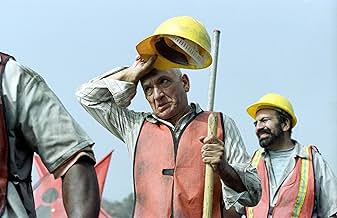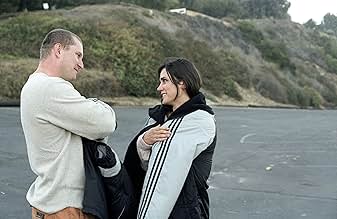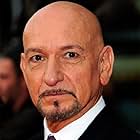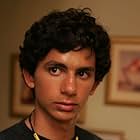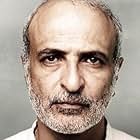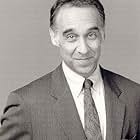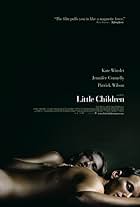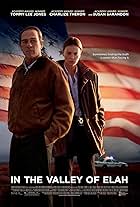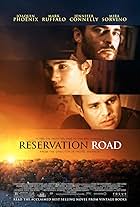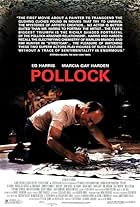An abandoned wife is evicted from her house and starts a tragic conflict with her house's new owners.An abandoned wife is evicted from her house and starts a tragic conflict with her house's new owners.An abandoned wife is evicted from her house and starts a tragic conflict with her house's new owners.
- Nominated for 3 Oscars
- 13 wins & 42 nominations total
Namrata Singh Gujral
- Wedding Guest
- (as Namrata S. Gurjal-Cooper)
Nasser Faris
- Wedding Guest
- (as Al Faris)
Marco Rodríguez
- Mendez
- (as Marco Rodriguez)
- Director
- Writers
- All cast & crew
- Production, box office & more at IMDbPro
Storyline
Did you know
- TriviaAuthor Andre Dubus III received more than one hundred offers from movie studios who wanted to make his book into a movie.
- GoofsThe brief time line of Kathy's eviction from her home is completely unrealistic.
Featured review
The concept of the American dream emerged after World War II, when the US began to establish itself as a great world power. Since then, the dream of a better life, nurtured not only by American citizens, but also by foreigners who move there in order to find a more dignified survival, has been the subject of countless films, as in the drama House of Sand and Fog, Vadim Perelman's first film work.
In this feature film by Russian (USA based) Vadim Perelman, the concept of 'family' once again assumes an important place in the narrative, which revolves around Kathy (Connelly), an ex-addict who, after being abandoned by her husband, she is surprised by a notification that her house will be auctioned in order to pay taxes related to her company. The problem is that Kathy doesn't own any business - but before she can clear up the misunderstanding, the property is sold to an Iranian immigrant (Kingsley) for a value far below the market price. With nowhere to sleep, the girl gets help from Lester (Eldard), one of the police officers responsible for her eviction, who recommends a lawyer. Unfortunately, to resolve the impasse, the new owner of the house would have to resell it to City Hall for the same amount paid in the auction - something he refuses to do. From there, Kathy and Behrani (the immigrant) begin a real psychological battle that results in pain and suffering for all involved.
With a script bound by a structure in which it is not possible to measure or compare the dimension of suffering between Kathy and Behrani, director Perelman manages to create an excellent situation of injustice in which no one is to blame and everyone is a victim. And the mise-en-scène, aided by the natural landscape of Northern California, give the dense and suffocating atmosphere that surrounds the dreams of the two characters. Almost always surrounded by a strong fog, the much-disputed house is the very representation of this dream, which sometimes has the image dissipated by reality.
In fact, the beauty of this project (adapted from the book of the same name by Andre Dubus III) begins in its title: when identifying the house that becomes the center of the dispute as being from 'House of Sand and Fog', the film (and the book, of course,) summarizes, in a poetic way, the true meaning of property, which, for Kathy and Behrani, represents more than a simple material asset. For the girl, the house is both an icon of her past (since she inherited it from her father) and a symbol of her recovery. Keeping the property is a sign of maturity, of responsibility fulfilled - and losing it would be further proof of your inability to take care of yourself. For Behrani, the place represents, first and foremost, a good investment - and, consequently, the possibility of recovering part of the luxurious lifestyle he got used to in Iran, where he was an influential military man in the government. In addition, the immigrant counts on the money he will earn from the sale of the property to be able to pay for his youngest son's studies and, as if that were not enough, he still sees, in the property, a reflection of his old beach house. In other words: like sand and mist, which seem compact from a distance, but which slip through your fingers when touched, the house Kathy and Behrani wanted is an ethereal, elusive dream.
Another fascinating element of House of Sand and Fog concerns the personalities of its protagonists, who are not divided between 'Good' and 'Evil'. Behrani, for example, is an authoritarian man (inherited from his military past) and proud, but he is not cruel. And, despite recognizing that the simplest way to resolve the issue would be to return the property to the municipality, the subject considers (with some reason) that he should not be harmed by an administrative error - after all, he had worked hard to save the necessary money. To acquire the property and renovate it, and he cannot accept that his family's future is compromised by bureaucrats. Incidentally, Ben Kingsley, an actor with an already brilliant resume, delivers one of his best performances by perfectly illustrating his character's moral dilemma, humanizing him and transforming him into a complex and real figure. While portraying the Iranian's pride in resigning from the underemployment he had accepted to support his family, Kingsley moves the viewer in a scene in which the subject becomes totally vulnerable in the face of unexpected pain.
Meanwhile, the beautiful Jennifer Connelly takes on yet another suffering character and offers the ideal counterpoint to the usually confident Behrani, as Kathy always seems ready to fall apart. On the other hand, Officer Lester, played by Ron Eldard, is the only element of House of Sand and Fog who could be held responsible for all the suffering that unfolds, as he is a selfish guy who doesn't hesitate to use his badge to try to intimidate the immigrant family, revealing a despicable streak of xenophobia. And, since I mentioned the Behrani family, I must highlight the excellent performance of Shohreh Aghdashloo, who, as the wife of the ex-soldier, becomes the apparently most fragile person in history, since, as she does not understand English, it depends on the husband to understand what is happening - and unfortunately, Behrani is not very willing to explain the situation, leading her to fear even deportation (which would result in the death of her family, who are persecuted in Iran).
As much as the initial essence addressed by the plot seems to be somewhat empty or not very decisive, it is clear that the story manages to lean towards a brusque analysis of the choices we make and the modeling of our actions according to the individual principles of the characters. Once the climax starts to set in, it's impossible to deny how much depth the plot gains, revealing itself to be quite daring by touching pretentious social points, but without getting involved in a climate of cliché or falling into the fact that some films they intend to make social approaches end up forcing the development of facts in order to find out something in the end, as if they needed to force the public to have some kind of reaction or emotion. The investment in working minimally on the evolution of events is crucial so that everything that is articulated by the script gains credibility and gives a greater meaning to the film. The harmony captured by Perelman between the script and the direction is an interesting aspect to analyze, since we were able to perceive a certain affinity and awareness of what needed to be done to make a scene yield good moments. Using a lot of a dark and cold atmosphere, we can still see the director's pessimistic sensibility, as if he were warning the audience that the psychological and moral weights would be focused.
Perelman, by choosing a great cinematographer to accompany him, makes his tragic journey more surprising. Roger Deakins, responsible for the photography of the great Fargo, gives the proper treatment to the mist, making it a kind of character in the plot, as the presence of the natural phenomenon surrounds the house and surrounds certain spaces in a frightening way. Creating a melancholy and cold color scheme, Deakins helps Perelman build the mood of the film, which ends up being safely driven by the newcomer - especially when it comes to the performances. At times, Perelman reveals his inexperience in including less-than-subtle (or effective) shots, such as the one in which he rotates the camera around Connelly in order to create a superficially dramatic moment, but these small flaws do not compromise the final result.
House of Sand and Fog is a strong film, extremely touching. Its characters pursue their dreams in such a way that they put themselves in extreme situations. Furthermore, it is not a Manichean story. There are no good guys or bad guys, which brings the film even closer to real life. Ben Kingsley and Jennifer Connelly deliver truly inspired performances. The desperation of its characters seems to have been incorporated by the actors to the last hair and it is also in the actors that the strength of the film is based. The work shows how difficult it can be to pursue a dream. And it's not just about the American dream, it's about any desire we have. The film shows the rawness of life in a way that it is impossible to feel compassion for its characters. The viewer ends up feeling sorry not only for one side of the story, but for both. They don't want to harm each other, quite the opposite. They're just chasing their dreams, as they say we should. Sad and morally complex, House of Sand and Fog is a film that fits perfectly into the Great Theme of the 2003 films: the family drama.
In this feature film by Russian (USA based) Vadim Perelman, the concept of 'family' once again assumes an important place in the narrative, which revolves around Kathy (Connelly), an ex-addict who, after being abandoned by her husband, she is surprised by a notification that her house will be auctioned in order to pay taxes related to her company. The problem is that Kathy doesn't own any business - but before she can clear up the misunderstanding, the property is sold to an Iranian immigrant (Kingsley) for a value far below the market price. With nowhere to sleep, the girl gets help from Lester (Eldard), one of the police officers responsible for her eviction, who recommends a lawyer. Unfortunately, to resolve the impasse, the new owner of the house would have to resell it to City Hall for the same amount paid in the auction - something he refuses to do. From there, Kathy and Behrani (the immigrant) begin a real psychological battle that results in pain and suffering for all involved.
With a script bound by a structure in which it is not possible to measure or compare the dimension of suffering between Kathy and Behrani, director Perelman manages to create an excellent situation of injustice in which no one is to blame and everyone is a victim. And the mise-en-scène, aided by the natural landscape of Northern California, give the dense and suffocating atmosphere that surrounds the dreams of the two characters. Almost always surrounded by a strong fog, the much-disputed house is the very representation of this dream, which sometimes has the image dissipated by reality.
In fact, the beauty of this project (adapted from the book of the same name by Andre Dubus III) begins in its title: when identifying the house that becomes the center of the dispute as being from 'House of Sand and Fog', the film (and the book, of course,) summarizes, in a poetic way, the true meaning of property, which, for Kathy and Behrani, represents more than a simple material asset. For the girl, the house is both an icon of her past (since she inherited it from her father) and a symbol of her recovery. Keeping the property is a sign of maturity, of responsibility fulfilled - and losing it would be further proof of your inability to take care of yourself. For Behrani, the place represents, first and foremost, a good investment - and, consequently, the possibility of recovering part of the luxurious lifestyle he got used to in Iran, where he was an influential military man in the government. In addition, the immigrant counts on the money he will earn from the sale of the property to be able to pay for his youngest son's studies and, as if that were not enough, he still sees, in the property, a reflection of his old beach house. In other words: like sand and mist, which seem compact from a distance, but which slip through your fingers when touched, the house Kathy and Behrani wanted is an ethereal, elusive dream.
Another fascinating element of House of Sand and Fog concerns the personalities of its protagonists, who are not divided between 'Good' and 'Evil'. Behrani, for example, is an authoritarian man (inherited from his military past) and proud, but he is not cruel. And, despite recognizing that the simplest way to resolve the issue would be to return the property to the municipality, the subject considers (with some reason) that he should not be harmed by an administrative error - after all, he had worked hard to save the necessary money. To acquire the property and renovate it, and he cannot accept that his family's future is compromised by bureaucrats. Incidentally, Ben Kingsley, an actor with an already brilliant resume, delivers one of his best performances by perfectly illustrating his character's moral dilemma, humanizing him and transforming him into a complex and real figure. While portraying the Iranian's pride in resigning from the underemployment he had accepted to support his family, Kingsley moves the viewer in a scene in which the subject becomes totally vulnerable in the face of unexpected pain.
Meanwhile, the beautiful Jennifer Connelly takes on yet another suffering character and offers the ideal counterpoint to the usually confident Behrani, as Kathy always seems ready to fall apart. On the other hand, Officer Lester, played by Ron Eldard, is the only element of House of Sand and Fog who could be held responsible for all the suffering that unfolds, as he is a selfish guy who doesn't hesitate to use his badge to try to intimidate the immigrant family, revealing a despicable streak of xenophobia. And, since I mentioned the Behrani family, I must highlight the excellent performance of Shohreh Aghdashloo, who, as the wife of the ex-soldier, becomes the apparently most fragile person in history, since, as she does not understand English, it depends on the husband to understand what is happening - and unfortunately, Behrani is not very willing to explain the situation, leading her to fear even deportation (which would result in the death of her family, who are persecuted in Iran).
As much as the initial essence addressed by the plot seems to be somewhat empty or not very decisive, it is clear that the story manages to lean towards a brusque analysis of the choices we make and the modeling of our actions according to the individual principles of the characters. Once the climax starts to set in, it's impossible to deny how much depth the plot gains, revealing itself to be quite daring by touching pretentious social points, but without getting involved in a climate of cliché or falling into the fact that some films they intend to make social approaches end up forcing the development of facts in order to find out something in the end, as if they needed to force the public to have some kind of reaction or emotion. The investment in working minimally on the evolution of events is crucial so that everything that is articulated by the script gains credibility and gives a greater meaning to the film. The harmony captured by Perelman between the script and the direction is an interesting aspect to analyze, since we were able to perceive a certain affinity and awareness of what needed to be done to make a scene yield good moments. Using a lot of a dark and cold atmosphere, we can still see the director's pessimistic sensibility, as if he were warning the audience that the psychological and moral weights would be focused.
Perelman, by choosing a great cinematographer to accompany him, makes his tragic journey more surprising. Roger Deakins, responsible for the photography of the great Fargo, gives the proper treatment to the mist, making it a kind of character in the plot, as the presence of the natural phenomenon surrounds the house and surrounds certain spaces in a frightening way. Creating a melancholy and cold color scheme, Deakins helps Perelman build the mood of the film, which ends up being safely driven by the newcomer - especially when it comes to the performances. At times, Perelman reveals his inexperience in including less-than-subtle (or effective) shots, such as the one in which he rotates the camera around Connelly in order to create a superficially dramatic moment, but these small flaws do not compromise the final result.
House of Sand and Fog is a strong film, extremely touching. Its characters pursue their dreams in such a way that they put themselves in extreme situations. Furthermore, it is not a Manichean story. There are no good guys or bad guys, which brings the film even closer to real life. Ben Kingsley and Jennifer Connelly deliver truly inspired performances. The desperation of its characters seems to have been incorporated by the actors to the last hair and it is also in the actors that the strength of the film is based. The work shows how difficult it can be to pursue a dream. And it's not just about the American dream, it's about any desire we have. The film shows the rawness of life in a way that it is impossible to feel compassion for its characters. The viewer ends up feeling sorry not only for one side of the story, but for both. They don't want to harm each other, quite the opposite. They're just chasing their dreams, as they say we should. Sad and morally complex, House of Sand and Fog is a film that fits perfectly into the Great Theme of the 2003 films: the family drama.
- fernandoschiavi
- Jul 22, 2022
- Permalink
- How long is House of Sand and Fog?Powered by Alexa
Details
Box office
- Budget
- $16,500,000 (estimated)
- Gross US & Canada
- $13,040,288
- Opening weekend US & Canada
- $45,572
- Dec 21, 2003
- Gross worldwide
- $16,763,804
- Runtime2 hours 6 minutes
- Color
- Sound mix
- Aspect ratio
- 1.85 : 1
Contribute to this page
Suggest an edit or add missing content






